Spanish colonization had a profound impact on Filipino dance forms. The infusion of Spanish dances like the fandango and waltz into indigenous forms created unique dances such as the Tinikling and Cariñosa.
One significant influence of Spanish colonization on Filipino dance was the incorporation of new rhythms and choreography. Polka and mazurka rhythms enhanced the footwork and choreography of traditional Filipino dances.
Filipino dance also became a reflection of the colonial hierarchy, with social dances showcasing both Spanish elegance and Filipino ingenuity. For example, the Jota, a regional dance, emerged with variations that demonstrated cultural adaptation and resilience.
The resulting fusion of Spanish and indigenous influences created unique Filipino dance identities. These dance forms, such as the Tinikling and Cariñosa, are a beautiful blend of old and new, telling a rich story of cultural adaptation and resilience.
A Legacy of Spanish Dances
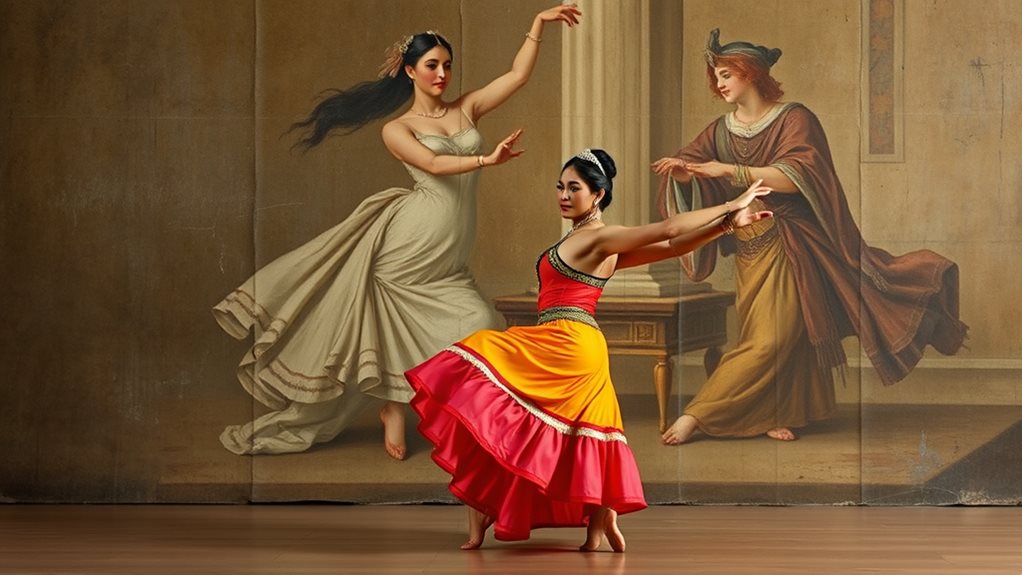
Spanish dances significantly impacted Filipino dance forms. Many traditional Filipino dances showcase Spanish influence, resulting from the blending of styles. The fandango, a lively Spanish dance, contributed to the rhythmic complexity and quick footwork in dances like Tinikling and Pandanggo. The fandango's rhythmic complexity was adopted in Tinikling and Pandanggo.
Similarly, the waltz, with its elegant grace, influenced the Cariñosa and Sayaw Santa Isabel.
The polka and mazurka further enriched the Filipino dance repertoire. These dances, along with the jota, a centuries-old Spanish dance, demonstrate the pervasive nature of Spanish influence on Filipino choreography. The adaptation involved a fusion of Spanish steps and rhythms with indigenous movements and musical instruments. This resulted in unique Filipino dances that retained the spirit of their Spanish origins while incorporating local elements.
The Rigodon is an example of this fusion. Influenced by the Spanish waltz, the Rigodon features elegant movements. The Pandanggo's intricate footwork echoes the Malagueña.
The lanceros, a reflection of European quadrilles, and the escotis, adapted from the Scottish schottische, further exemplify this creative process. The integration of Spanish musical instruments, like the guitar and castanets, into existing ensembles and creating new ones, such as the rondalla, also played a key role in this process.
Religious Dances' Transformation
Spanish colonization profoundly shaped Filipino religious dance traditions. The introduction of Catholic rituals and festivals significantly altered the landscape of Filipino religious expression. For example, indigenous rhythms and ritual symbolism were integrated into newly adopted Catholic celebrations, resulting in dances like the Sinulog, a vibrant blend of indigenous and Catholic elements.
The transformation of indigenous dances was a complex process. Existing indigenous dances evolved, with their movements and themes subtly altered to align with Catholic practices. Religious themes became prominent, reflecting the new faith's influence.
Spanish musical instruments were incorporated, enriching the sonic tapestry of religious dance. Regional variations arose, testament to the resilience of local cultures in adapting and reinterpreting the imposed forms.
Dance performances became integral to fiestas, honoring saints and commemorating religious events. Local communities actively participated, using dance to express their faith.
The deeper meaning of these dances evolved, reinterpreting religious stories and themes through movement, making dance itself a potent form of devotion. The continued use of indigenous rhythms and ritual symbolism within this new context exemplifies both cultural preservation and subtle resistance to colonial erasure.
Birth of Fusion Dances
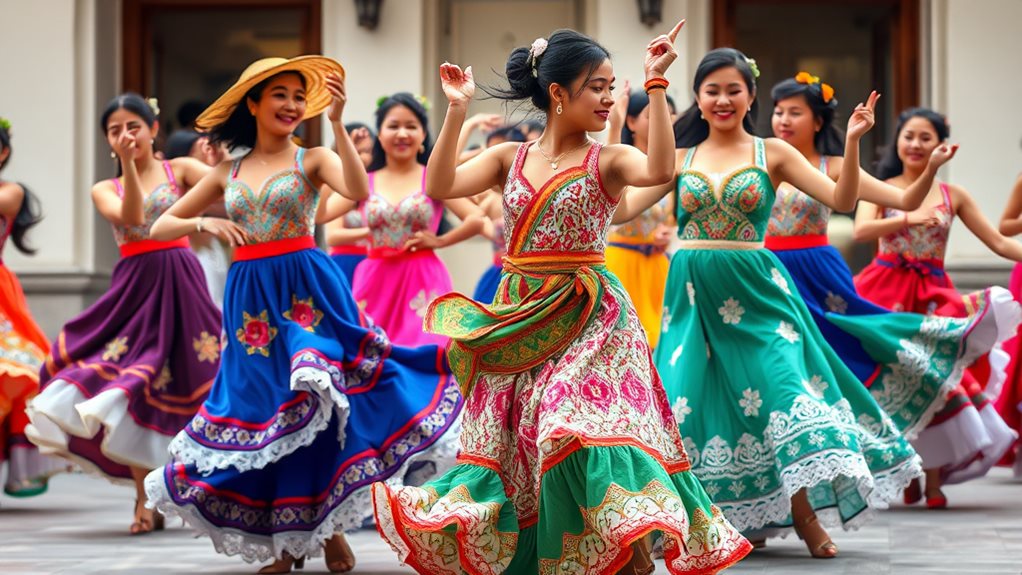
European colonial rule significantly influenced the development of Filipino dance**. As a result, Filipino dance underwent a dramatic transformation, absorbing and adapting numerous European forms. For instance, the waltz's elegant sway is incorporated into dances like the Cariñosa**.
The fusion of European and Filipino dance styles created unique fusion identities**. The fandango's energetic rhythm influenced the Tinikling's quick footwork, while the jota, a Spanish courtship dance, evolved into regional variations like the Jota Cagayana and Jota Isabela**. Polkas and mazurkas also gained popularity, enriching the dance repertoire.
Filipino dances adopted elements from European forms while maintaining local adaptations. The Rigodon, derived from the French quadrille, and the Lanceros, adapted from the lancers, became staples of social gatherings and formal balls.
The Pandanggo integrated elements of the Malagueña, and the Jota Moncadeña blended Spanish and Ilocano styles. Regional variations, such as Cavite's Jota with its bamboo castanets, further demonstrate this creative dance evolution.
These fusion dances became integral parts of Filipino culture****. They weren't merely imitations; they became vessels for expressing Filipino identities, weaving indigenous movements and styles into the new forms.
The dances became integral parts of festivals and celebrations, solidifying their place within Filipino culture.
New Musical Instruments Arrive
The fusion of European and Filipino dance styles led to the introduction of new instruments. This fusion not only affected choreography but also instrumentation. The guitar, a pivotal instrument in the musical adaptation of traditional dances, was introduced during this period. Other instruments, such as the octavina and bajo de uñas, which were adaptations of Spanish instruments, also enriched the soundscape.
The Spanish guitar's use led to a process of musical adaptation. The plectrum, traditionally used in Spanish music, was readily adopted for Filipino stringed instruments, influencing playing styles. For example, the rondalla ensemble, featuring Spanish-introduced instruments like the banduria, laud, and guitar, became a powerful symbol of this musical adaptation. This ensemble became integral to dances like the Pandanggo and Jota, showcasing a seamless blend of cultures.
Regional variations of Spanish dances were enhanced and reinterpreted through the use of new instruments. The Fandango and Malagueña, for instance, were reinterpreted in rural and indigenous dance forms. This is evident in the rhythmic patterns in Tinikling, which reveal the subtle influences of the Fandango, further amplified by the accompaniment of these new instruments.
Similarly, the Rigodon's courtly gestures, performed to the tempo of a Spanish Waltz, gained a richer sonic tapestry.
The new instruments left a lasting legacy in modern Filipino folk dances. The sounds and cultural identities of these dances were shaped by these instruments, preserving a unique blend of cultural identities. This legacy can be seen in the continued use of these instruments in modern Filipino music and dance.
Dance in Social Gatherings
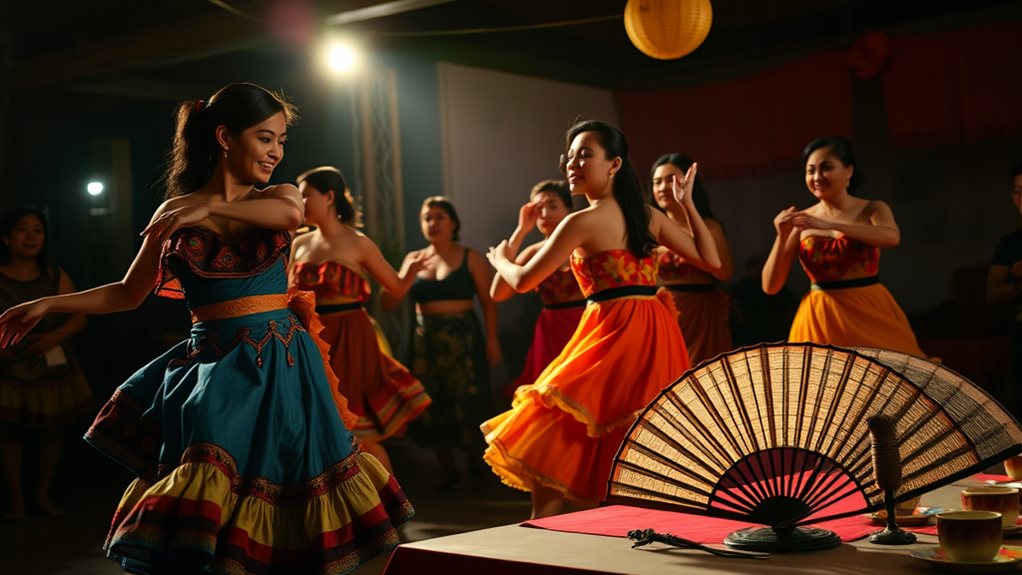
Traditional Filipino dances played a significant role in social gatherings during the Spanish colonial era and beyond. Various dances, such as the Carinosa and Jota, were frequently performed at weddings and other festive occasions. These performances showcased a blend of Spanish and Filipino traditions, reflecting the cultural exchange between the two.
Formal balls featured elaborate dances that displayed European elegance. The Rigodon and Lanceros were commonly performed at government functions and other formal settings, highlighting the influence of European culture on Filipino social gatherings. In contrast, community events like the guling-guling incorporated the Jota, demonstrating its widespread appeal.
Regional variations of traditional dances emerged, showcasing unique cultural fusions. The Jota Moncadeña, for example, combined Spanish and Ilocano styles, while the Jota Cagayana and Jota Manileña were significant in courtship rituals.
Courtship dances were an essential part of Filipino social gatherings. The Carinosa, originating in Panay, depicted courtship without physical contact. The Pandanggo sa Ilaw, with its Southeast Asian roots, incorporated Spanish tempos like the jota and polka, becoming a staple of social gatherings.
The fusion of Spanish and indigenous styles created unique dances. The Polkabal and Jotabal, for instance, were products of this cultural exchange. The Rigodon and Tinikling evolved over time, absorbing American influences while retaining their Spanish and indigenous cores.
Filipino dances were performed in diverse settings, reflecting their deep integration into Filipino culture. From grand ballrooms to humble community gatherings, these dances left a lasting legacy in Filipino society. Rondalla ensembles provided musical accompaniment, adding to the richness of these cultural performances.
Spanish Dance and Hierarchy
Spanish colonization had a profound impact on Filipino dance, resulting in a rigid social hierarchy reflected in dance styles and performance contexts. The introduction of European dances like the waltz, polka, and fandango created a system of dance patronage reflecting the Spanish hierarchy.
Wealthier Filipinos adopted elaborate costumes and formal styles, such as the elegant rigodon, to showcase their status. This formal dance style, characterized by slow and elegant movements, was often performed at grand balls. Conversely, dances adapted from folk traditions retained a more informal, regional character. For example, the fandango, a lively and energetic dance, was often performed in simpler settings.
Dance styles themselves became stratified, with different social connotations. The waltz, with its elegant movements, was associated with the elite, while the fandango was associated with the common people. Performance contexts also reflected this social hierarchy. Grand balls featuring European-style dances were the domain of the elite, while simpler dances were performed in more informal settings.
Costume was another marker of social status. Elaborate gowns and formal attire signaled wealth and high social standing. The evolution of the Maria Clara dress and the Barong Tagalog reflected the Spanish cultural influence on Filipino attire.
The careful observation of dance styles and attire reveals a complex interplay between Spanish cultural influence and the existing social fabric of the Philippines. This social stratification is evident in the very choreography and costuming of Filipino dance, reflecting the enduring impact of the Spanish colonial period.
Cultural Preservation Efforts
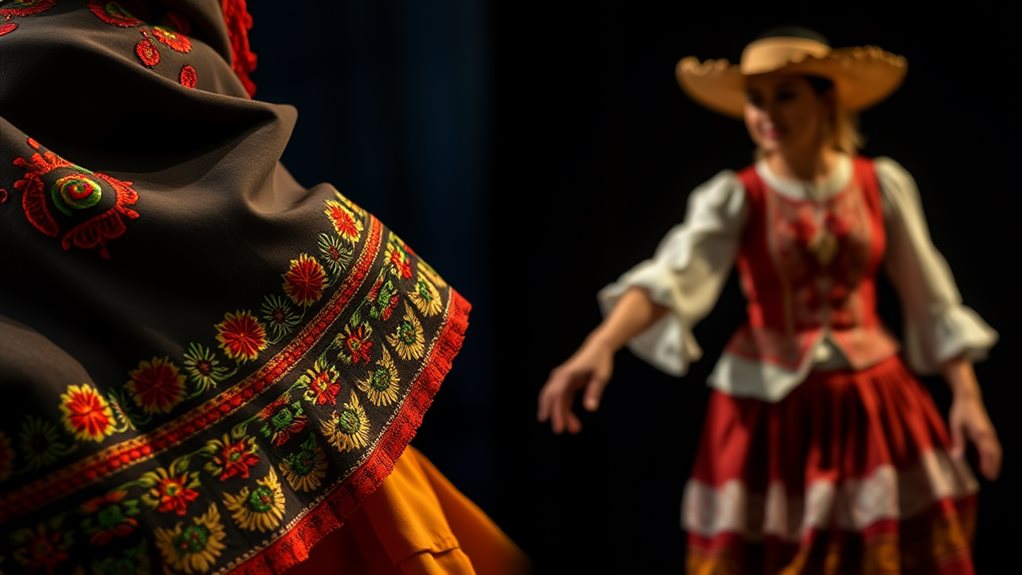
Filipino dance forms have shown remarkable resilience despite centuries of colonial influence. This is evident in the complex interplay between adaptation and preservation of traditional dances.
Francisca Reyes Aquino, a researcher, played a crucial role in meticulously documenting and reviving these dances.
Educational initiatives have been instrumental in safeguarding Filipino cultural heritage. Universities have established folk dance groups, providing training and nurturing future generations of dancers and musicians.
For instance, the University of the Philippines' dance company has been actively involved in preserving traditional dances.
Community involvement is key to preserving Filipino cultural identity. Spanish-influenced dances, such as the Tinikling, are integral parts of social gatherings, fiestas, and religious processions like the Sinulog.
These dances are woven into the fabric of Filipino social life, adorning weddings and even government functions.
The fusion of indigenous and Spanish elements demonstrates adaptation and preservation of cultural identity. This is evident in the Cariñosa, a traditional dance that combines Spanish and Filipino elements.
The ongoing use of these dances adapts Spanish forms to local customs and preferences, reflecting a dynamic exchange rather than mere imitation.
The power of dance as a vehicle for cultural resistance and continuity is evident in Filipino cultural identity. The rich interplay between tradition and innovation has shaped a unique and enduring Filipino cultural identity.
The Waltz in the Philippines
The Waltz in the Philippines: A Legacy of Cultural Exchange****
The introduction of the waltz in the Philippines during the Spanish colonial period had a lasting impact on the country's dance traditions. By the 19th century, the waltz had gained popularity and was integrated into various Filipino dances. This cultural exchange is evident in dances like the balitaw, a lively courtship dance that incorporates waltz movements.
The waltz's influence on Filipino dance forms is undeniable. Dances like the Balse, popular in Marikina during Spanish times, and the Jotabal, a fusion of jota and valse, showcase the waltz's impact. The waltz's 3/4 time signature became a common rhythm in many Filipino dances. These dances were often performed after religious processions, accompanied by bamboo instruments, and reflected the elegance and formality of the waltz.
The waltz also introduced European instruments like the guitar, which became integral to many Filipino dances. The rondalla, a small string orchestra, incorporated instruments like the banduria, laud, and guitar, all adapted from Spanish originals. These ensembles enriched the musical landscape and influenced the development of Filipino folk music.
The waltz played a significant role in Filipino social life, particularly in formal events. It was performed at formal balls and government functions, reflecting the social standing of those who embraced it.
The waltz also became a part of Filipino social gatherings, such as weddings and fiestas, and fostered the creation of fusion dances that blended Spanish and indigenous elements.
Polka's Filipino Adaptation
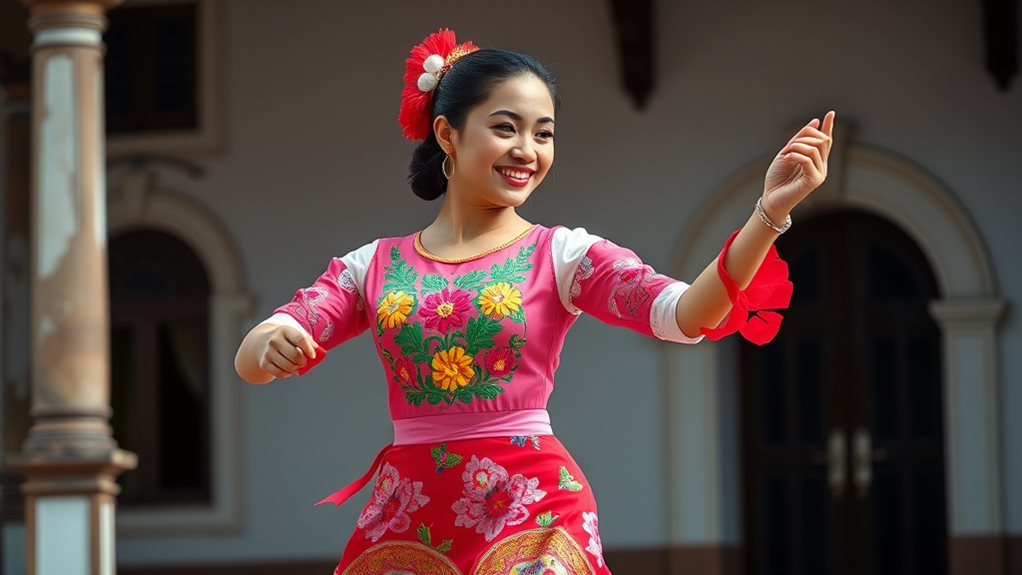
The Polka's Integration into Filipino Dance Traditions****
The polka, a European dance form popularized in 1859, found its way into the Philippines and became a staple at local fiestas and social gatherings. As it was adopted, the polka underwent cultural fusion, resulting in regional adaptations such as Polka sa Nayon in Batangas, Polka Tagala in Bataan, and Polka Antigo in Negros Occidental.
Regional Variations and Local Preferences****
These variations weren't mere copies; they reflected local preferences in terms of formations and styles. For example, in Batangas, dancers performed in sets of four pairs, while in Bataan, ladies showcased their petticoats with a flourish.
Local adaptations were characterized by distinct formations and styles that set them apart from the original European polka.
Incorporation into Existing Filipino Dances
The basic polka step, a step-close-step pattern, was incorporated into existing Filipino dances such as Tinikling and Pandanggo sa Ilaw.
The polka step added a new layer of energy to these dances, resulting in a playful and lively quality. This blending of European rhythms with indigenous movements enriched the cultural identity of the dances.
Rhythmic Adaptation and Cultural Fusion
The incorporation of the polka into Filipino dances wasn't just about steps; it was about a distinctive, rhythmic adaptation reflecting the creative cultural fusion of European and indigenous dance styles.
The result was a vibrant tapestry of movement, showcasing the power of cultural exchange.
Fandango's Lively Influence
The fandango, a Spanish colonial influence, significantly impacted the evolution of Filipino dance. Its introduction to the Philippines led to a unique blend of Spanish flair and indigenous Filipino movement vocabularies.
The fandango, originating in Spain, underwent cultural adaptation in the Philippines. Filipino dancers integrated its characteristic footwork into existing movement styles, creating a distinctive fusion.
Key characteristics of the fandango's influence on Filipino dance include:
- Lively, intricate steps that reflect both Spanish and Filipino sensibilities.
- Rondalla music and other instruments, such as guitars and bandurrias, which accompany the dance.
- Seamless fusion of Spanish and Filipino dance elements, demonstrating the ability of Filipino artistry to absorb and transform external influences.
The fandango's impact extends beyond aesthetics. It became a staple at fiestas and social gatherings, showcasing the cultural exchange of the colonial period.
Its enduring popularity demonstrates the power of cultural synthesis, allowing Filipino artistry to shape foreign influences into something uniquely its own.
Jota's Regional Variations
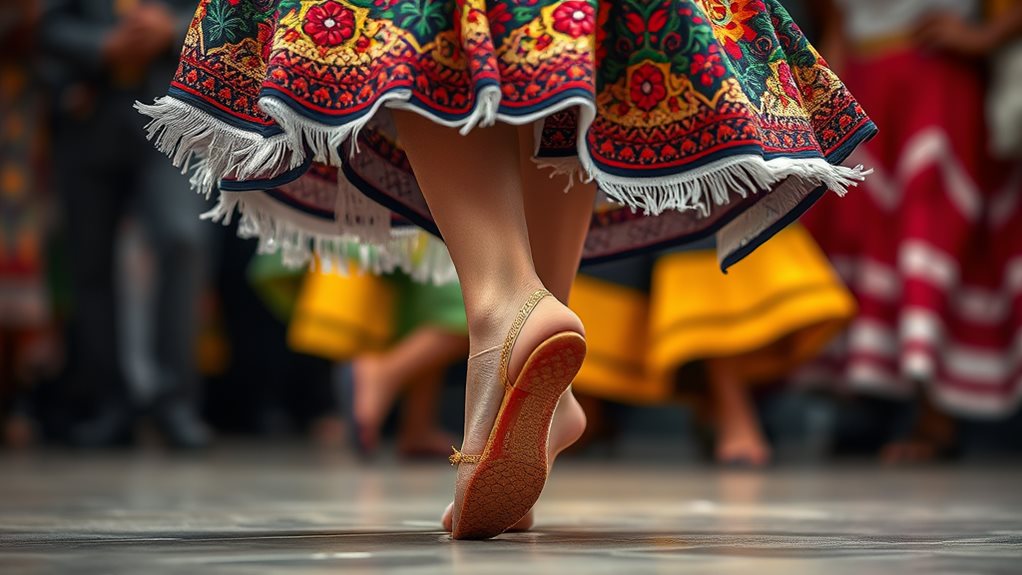
The jota is a dance form with diverse regional variations across the Philippines, shaped by Spanish colonization. These variations reflect the cultural significance of the jota within each community.
The Jota Manileña, from Manila, is characterized by its use of bamboo castanets and Spanish-inspired costumes. This jota incorporates these elements into its Castilian base.
The Jota Caviteña, from Cavite, blends Spanish and Filipino steps and music. This blend is often accompanied by the Philippine rondalla. Other regional variations include the Jota Moncadeña from Tarlac and the Jota Paragua from Palawan's Cuyo Islands.
Regional adaptations of the jota aren't just stylistic choices but reflect the cultural significance within each community. The use of the Philippine rondalla and bamboo castanets adds unique rhythms and textures to the music.
The music alternates between fast and slow tempos, mirroring Spanish airs. Regional instrumentation further diversifies the sound.
Choreographically, variations in footwork, arm movements, and props are prominent. Zapateados and cubrados are particularly prominent in the Jota Paragua. Props like mantón, parasols, fans, and kerchiefs are also used.
The flounced dresses of the Jota Paragua recall the Sevillana style.
These regional jotas are testaments to the dynamic interplay between Spanish colonial influences and Filipino ingenuity. Their evolution, from social gatherings to choreographed performances in zarzuelas and films, highlights their enduring cultural significance.
Maria Clara's Graceful Steps
The Maria Clara dance is a traditional Filipino dance that emerged from the Spanish colonial era, embodying a blend of Spanish and Filipino traditions.
The dance is named after the iconic character from José Rizal's Noli Me Tángere**. It isn't a single dance, but rather a suite of dances reflecting Spanish influence** adapted to local culture.
The dance's cultural expression is evident in the costumes, with women wearing elegant saya, camisa, tapis, and panuela, while men wear the barong Tagalog. These garments, along with fans and handkerchiefs, contribute to the dance's overall elegance.
The dance's movements are characterized by graceful steps, often resembling a waltz, sometimes depicting courtship. The dancers' movements, whether lively or demure, are a blend of Spanish and Filipino styles.
The music, often played by a rondalla, further enhances this blend, with lively melodies perfectly complementing the dancers' steps.
The Maria Clara dance's historical significance lies in its ability to showcase the cultural fusion between Spanish and Filipino traditions. The dance isn't simply a performance but rather a testament to the enduring legacy of Spanish colonization on Filipino cultural expression.
The Maria Clara dance's elegant steps represent a unique aspect of Filipino cultural heritage.
Cariñosa's Courtship Charm
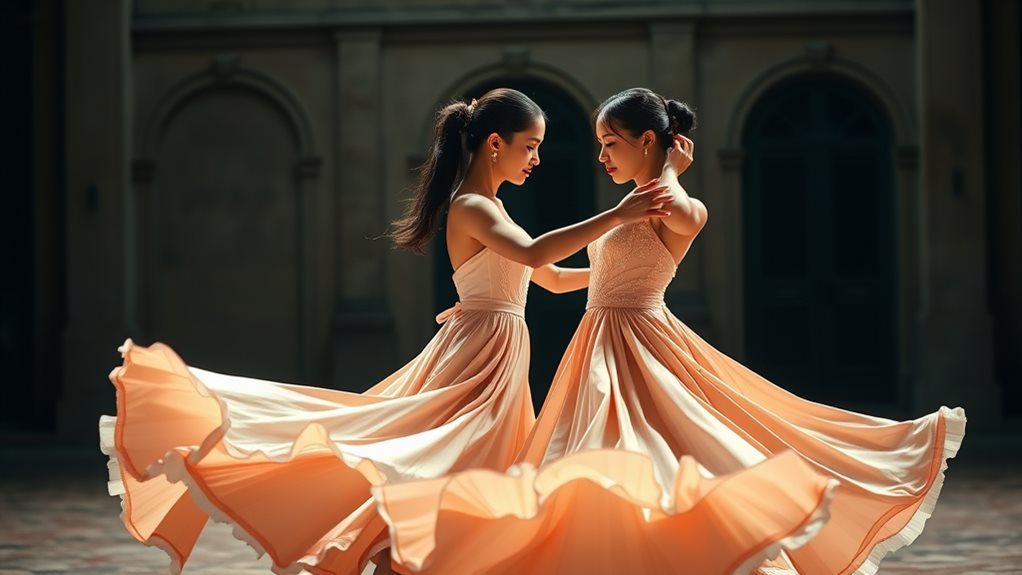
The Cariñosa: A Traditional Filipino Dance with Spanish Influences****
The Cariñosa is a traditional Filipino dance that originated in the 17th century on Panay Island during the Spanish colonial era. Its roots are intertwined with Spanish influences, reflecting a cultural fusion evident in its steps and symbolism. This dance is part of the Maria Clara suite, which showcases intricate costumes and lively music.
The Dance's Courtship Symbolism****
The Cariñosa's hide-and-seek movements represent a subtle, coded language of courtship. The elegant swaying and expressive hand gestures mirror the careful advances and responses in traditional courtship rituals. These movements aren't random, but carefully choreographed steps and gestures designed to convey meaning.
For example, the quick footwork underscores the excitement and energy of young love.
Partnership and Regional Variations****
The partnership between the gentleman and lady is crucial, reflecting societal norms during the colonial era. The gentleman leads, and the lady responds, their interaction a subtle ballet of trust and nonverbal communication.
The flirtatious teasing is a key element, enriching the courtship symbolism. The dance's regional variations add to its richness, showcasing diverse interpretations of flirtation techniques within the broader framework of Filipino courtship.
The Significance of the Cariñosa
The Cariñosa isn't just a dance, but a vibrant testament to cultural exchange and the enduring power of courtship rituals. Its use of a fan or handkerchief as central props in the flirtation techniques employed by the dancers highlights the dance's emotional depth.
The Cariñosa's ability to convey meaning through movement and gesture makes it a unique and captivating dance.
Questions and Answers
How Did Dance Resist Spanish Rule?
You resisted Spanish rule through dance by blending cultural traditions.
Indigenous people subtly resisted Spanish rule by incorporating their folk traditions into the colonial framework. They combined Spanish dance styles with their own cultural identity. This blend allowed them to preserve their heritage while still adhering to the imposed Spanish culture.
Examples of resistance through dance include the use of indigenous instruments and movements. In many Latin American countries, traditional dances incorporated Spanish styles, such as the waltz or flamenco, but still maintained elements of indigenous culture. For instance, the Mexican 'jarabe tapatío' dance combines Spanish and indigenous influences, reflecting the blending of cultural identities.
The persistence of indigenous movements and instruments played a significant role in preserving cultural heritage. Despite the imposition of Spanish rule, indigenous people continued to perform their traditional dances, often incorporating Spanish elements to avoid persecution. This allowed them to maintain their cultural identity while still adhering to the colonial framework.
What Dances Predate Spanish Influence?
Many traditional Filipino dances originated before Spanish colonization. These dances showcase indigenous rituals and cultural symbolism, reflecting diverse pre-colonial Filipino traditions. For example, the Tinikling is a traditional dance that mimics the movement of a bird, demonstrating the community's connection to nature. Another example is the Singkil, a dance that expresses the community's respect for their ancestors. These dances express community life and beliefs.
What Other Colonizers Impacted Dances?
Multiple colonizers impacted Filipino dances. The Philippines experienced influence from various countries, including the United States, Japan, and China. American influence, for example, led to the adaptation of Western-style ballroom dances such as the waltz and foxtrot. In contrast, the Japanese occupation resulted in the incorporation of martial arts elements into traditional Filipino dances, such as the use of sticks and swords. Additionally, Chinese integration contributed to the development of dances like the Lion Dance, which is often performed during Chinese New Year celebrations. Despite these external influences, indigenous traditions persisted, blending with these external forces to create a unique cultural identity in Filipino dance.
Did Filipino Music Influence Spain?
No evidence suggests that Filipino rhythms impacted Spanish melodies.
The cultural exchange during Spanish colonization of the Philippines was primarily one-way. This means that Spanish culture, including music, was imposed on the Philippines, rather than the other way around. As a result, Spanish styles had a significant influence on Filipino music, but there is no clear evidence to suggest that Filipino rhythms had a noticeable impact on Spanish music.
How Did Dance Reflect Social Class?
Dance has historically reflected social class through various elements, including costumes and performance settings.
Dances showcasing upper-class status were often elaborate. These dances, such as the Minuet, featured intricate steps and required formal training. In contrast, simpler forms of dance, like folk dances, were more accessible and offered broader cultural expression.
For example, in the 18th century, the upper class would often host balls featuring complex dances like the Quadrille. These events were held in luxurious settings and required participants to wear formal attire, such as corsets and tailcoats. In contrast, folk dances like the jig were performed in more casual settings and required minimal training or formal attire.
The distinction between upper-class and lower-class dances was also reflected in their performance settings. Upper-class dances were often performed in grand ballrooms or theaters, while lower-class dances were performed in village squares or community centers.